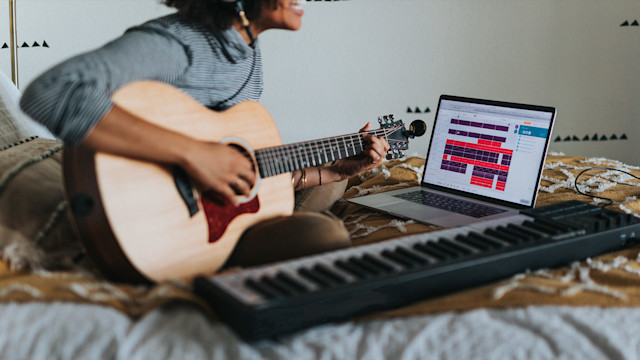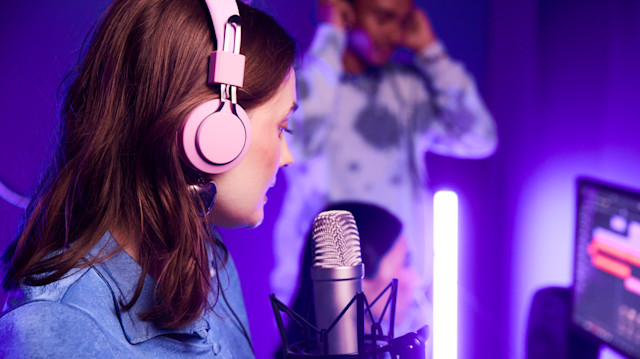How to Collaborate with Musicians Online: The Do's and Dont's
May 2, 2024 - Strum up successful online music collaborations! This guide dives into the do's and don'ts of working remotely with musicians, ensuring your next project is a harmonious masterpiece.

Do you want to make sure your next music collaboration is a success?
Working with musicians online can feel intimidating, but it doesn’t have to be.
Collabs can help you get authentic feedback and speed up production time. More importantly, together, you can create something that doesn’t sound like anything else–A piece that has never been done before.
Working with other musicians can be vulnerable, and there are many aspects to consider such as task delegation, coming up with a theme, connecting as a team, and more. In this article, we’ll discuss how to collaborate with artists in detail.
Read more: Collaborate — from anywhere — with anyone
Step 1: Find Artists to Work With
Step one is finding artists to work with. Soundtrap’s platform makes it easy to find artists to work with online - You can simply make a song and invite someone to add to it or click the ‘start a collaboration’ button once you’ve logged in to the studio.
Community spaces online like music-making forums are great places to find musicians to collaborate with. The beauty of the internet is that you can work with anyone in the world.
Another easy place to start is by inviting the people you know in person, or those you game with online. You might be surprised how many of your friends and family members are musically inclined, even if they don’t identify as an artist.
Don’t: Select every collaboration invite that you get
Have you ever opened up a social media platform to find loads of messages in your inbox that all look something along the lines of this: “Hey, let’s collab!”
These types of flat-feeling messages are a dime a dozen. Sometimes artists want to access your followers more than they want to connect with and work with you.
That’s all to say: Don’t be afraid to be selective.
There was a time when my messages were flooded with these collaborative invites on Instagram. There was also a time when I always said “Yes” to collaborations.
Doing too many collaborations at once isn’t a good idea: focus on one at a time and give it your all, then move on to the next one. Additionally, saying yes to collaborations just because the musician has a large following isn’t always a good idea. Make sure that the invite is authentic, and that the artist has actually looked through your work or decided to work with you specifically - as opposed to those sending out invites en masse.
Step 2: Start the Online Music Collaboration
Once you’ve found a musician to work with, the next step is starting the song. If you don’t know where to begin, use songwriting tools or try out a cover.
Do: Utilize Tools If You Don’t Know Where to Start
Be aware that writer's block can also happen in a collaborative setting. Decide whether you want to start with music first or lyrics first. Both chord progression and words are excellent jumping-off points. Once you have a strong progression or emotive words, the rest of the tune often writes itself.
Soundtraps chord picker is a great way to start a song chordally. Begin by choosing a key and tempo, and then the tool will automatically suggest chords for you. Other tools like books of poetry-writing prompts and journaling prompts can spark inspiration for lyrics.
Do: Try a Cover Song
Remaking famous songs is a great way to start a collaboration. Without having to start everything from scratch, you can still make something that sounds new and fresh. The beauty of starting a music collaboration in the form of a cover song is that the roadmap is already laid out for you - all you need to do is lay down the beat and chords, and make it your own.
Tips for Online Music Collaborations
Don’t: Start Without Connecting
Starting a project too quickly without having a pre-songwriting conversation is a recipe for disaster - especially if you don’t know your collaborator well yet.
Using online video chats is a great way to bounce ideas back and forth meaningfully. Try wearing your heart on your sleeve - talk about the musical feelings you’d like to cultivate with your collaborator(s). Break into your feelings and form an authentic connection before you start writing.
Do: Step Outside of the Box
Step outside of your box both musically - but also, step outside of your own comfort zone. Try prompts or loops that you wouldn’t normally use if you were working solo.
Jazz bassist/music theory expert Adam Neely is a wonderful artist to listen to to help you do think outside the box. In his videos he talks about the effective use of musical space, how to build walking basslines, and even gives some unusual songwriting prompt ideas. One prominent example is the idea of multitrack recording with your band without listening to what each other has laid down, to come up with new textures and ideas to play with.
Do: Play to Each Other’s Strengths
Just think of One Direction - A band with members who weren’t vocally strong enough to stand on their own yet…They still turned into the most popular boyband of the 2010s.
I’m a flutist with a keen ear for vocal harmonies - but sometimes it can be difficult for me to get that ‘bed of sound’ underneath my music and a chord progression that is unique and fun. That’s why I love collaborating with jazz guitarists in real-time.
You can play to each other's strengths in online music collaborations like this as well. If you’re great at making music but not so great at producing, try inviting a pro producer to work with you on your project.
Don’t: Get Greedy with Sound
Suddenly getting “sound greedy” and adding too much to a collaborative project on your own might make your collaborator feel left-in-the-dust. Even if you’re feeling it, hold up and wait to see what your collaborator thinks.
As a piano professor of mine once said “Music is 90% psychology and 10% music;” at the time he said this in regards to teaching music, but the same goes for musical collaborations. Music is a sensitive thing - It’s vulnerable and subjective, so take it slow and be mindful.
Assigning roles to one another can help create a clear framework, and make moving forward seamless. Collaborating with other musicians can also help you complete tasks faster since different tasks can be delegated, and worked on in tandem.

The Technical Side of Online Music Collaborations
Do: Be Professional
Put the project in your calendar
Be honest and open-minded
Accept criticism with grace
When you collaborate with artists, treat it like a job, and put it in your calendar. Be honest and open-minded with your partner. If there’s something you'd like changed in the song, be candid but gentle about it.
If you receive constructive criticism when you collaborate with artists, try not to take it personally. Constructive criticism gives musicians a chance to improve and receive valuable feedback. On the other hand, you might be surprised what parts your collaboration likes - they might be the sections you think are “Just ok”.
Don’t: Be Lax About Editing and Equipment
Musically, put your best foot forward. It goes without saying, but using the best equipment you have on hand is very important.
If you can help it, try to avoid using your computer's microphone. Small mics that plug into your lightning/USB port work great.
Also, keep in mind that It’s easier to record tracks in a quiet space than it is to have to cut out unwanted noise with post-production.
If you’re not happy with something you recorded for your collaboration, don’t be afraid to use technology to help you out. After all, it’s there for a reason! If you’re a bit pitchy, don’t be afraid to use a vocal tuner like the one built into Soundtrap. If you can’t record without catching a bit of road noise, cut down on the extra sound by carefully EQing.
Do: Make Sure You Are Locked-In
When you are recording from scratch, make sure your rhythms are really crisp and your harmonies are confident and in tune. If you don’t sound locked in, keep recording until you are. The best music is made when the recording is as good as it will get– and then editing tools like quantize or vocal tuner are used to take it one step further.
Being locked in is also a mindset. Making sure you’re coming into the collaboration alert and focused will go a long way.
Create Something Beautiful: Collaborate With Artists
If you get the right people together, collaboration can be beautiful, creating a collection of sounds and strong sonic ideas that have never existed before. You can up your productivity, boost each other's fan bases, and play to each other's strengths to make a locked-in bop.
Now, collaboration through Soundtrap allows you to work with musicians who you may have never encountered in the world. If you haven’t made an account yet, start one for free today.
About the author
Aleah Fitzwater is a multi-instrumentalist, songwriter, music journalist, and blogger from Temperance, United States. Aleah holds a Pk-12 instrumental music education degree. Her main instruments are flute, piano, drums, bass, and guitar.
Kom igång med Soundtrap idag!